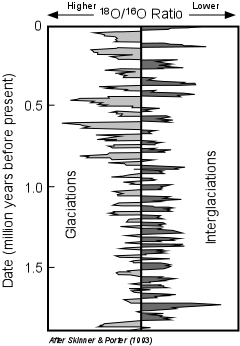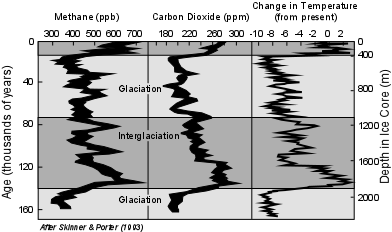Other Consequences of Glaciation
Ice Loading and Glacial Rebound
The weight of glacial ice sheets depress the lithosphere into the mantle causing the crust to subside. After the ice melts, the depressed lithosphere rebounds. The rebound process is still taking place today (see figures 22.23 in your text).
Sea Level Changes
- During glacial periods much sea water was tied up in glaciers so sea level was lower.
- during interglacial periods sea level was higher due to melting of the ice.
Ice Dams, Drainage Reversals, and Lakes
When glacial ice forms, it can block existing drainages causing the formation of new lakes and forcing streams to find new pathways that develop into new drainage networks. Once the ice melts, the new drainage network become well established and the old drainage networks are often abandoned.
Such a change in drainage networks took place as a result of the last ice age in North America (see figure 22.24 in your text book). Prior to glaciation, streams in the northern U.S. and Canada drained to the northeast into what is now Hudson Bay and only the southern part of the U.S. drained into the Mississippi River system. Because the glacial ice retreated toward the north, the Mississippi drainage system became the major drainage system for much of the U.S.
During the Pleistocene Epoch, large lakes formed both as result of ice dams and melting of glaciers. Examples include the Great Lakes of the northern U.S., and a now much reduced lake, Lake Agassiz the formed from northern Minnesota, into the Canadian provinces of Manitoba, Saskatchewan and Ontario. As ice melted, lakes were also formed in the western U.S. at large distances from the glacial source. For example in the Basin and Range Province, basins were filled with large lakes formed by internal drainage. One of these lakes. Lake Bonneville, covered much of western Utah, eventually draining and evaporating leaving the remnant called the Great Salt Lake.
|

